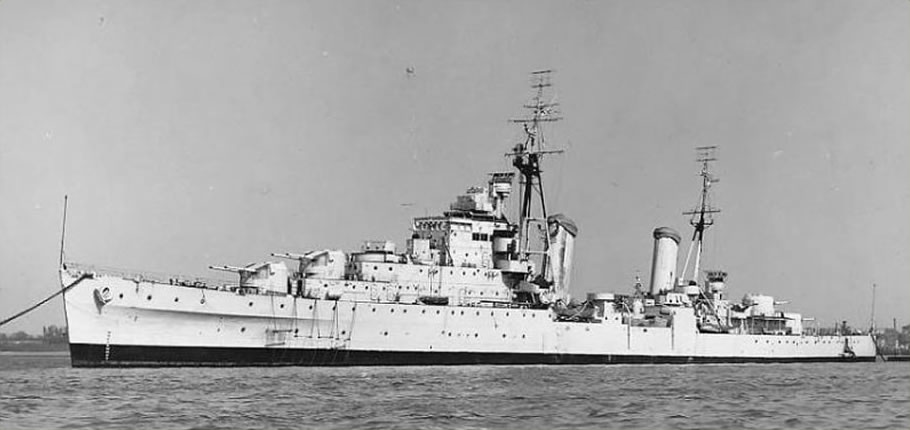
Cruisers – World War 2
The heavy cruiser was designed for long range, high speed, and heavy calibre naval guns. The first heavy cruisers were built in 1915, although it only became a widespread classification following the London Naval Treaty in 1930. The heavy cruiser’s immediate precursors were the light cruiser designs of the 1910s and 1920s; the US 8-inch ‘treaty cruisers’ of the 1920s were originally classed as light cruisers until the London Treaty forced their redesignation. Heavy cruisers continued in use until after World War II.
Cruisers were usually armed with torpedo tubes, and often are fitted with facilities for carrying one to three floatplanes. They usually had a top speed of around 30 knots, were designed to mix speed with range, endurance and firepower, and were expected to be able to out-run any ship they can’t out-fight.
HMS Calcutta
- Type. Cruiser
- Class. Capetown
- Pennant. D82
- Builder. Vickers
- Ordered. 1916
- Laid Down. 18/10/1917
- Launched. 09/07/1918
- Commissioned. 28/08/1919
- Speed. 29 knots
- Fate. Sank 01/06/1941
-
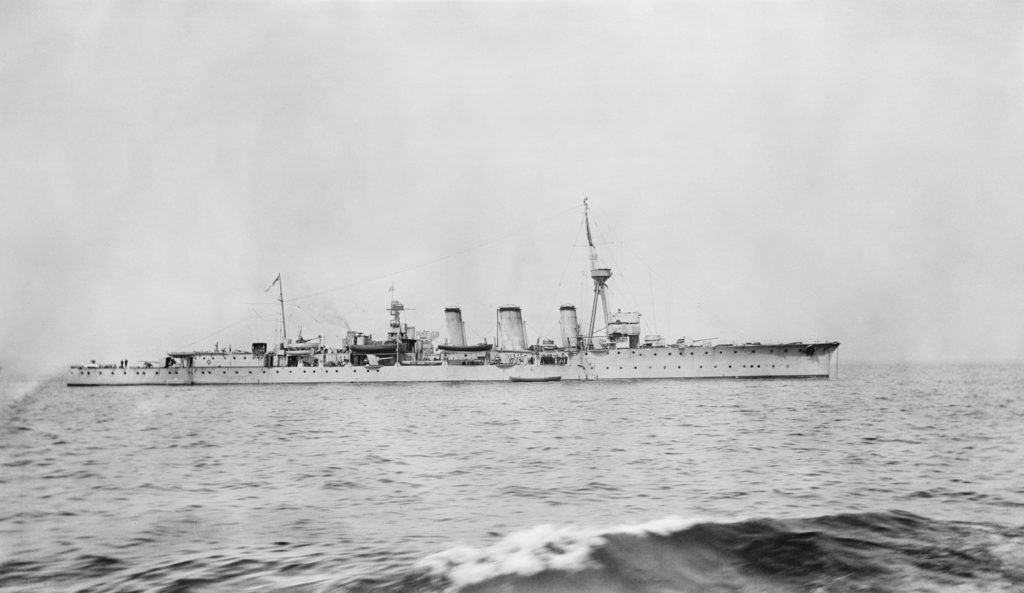
HMS Calcutta
HMS Calcutta was a Capetown Class Cruiser. She was laid down by Vickers Limited at Barrow-in-Furness in 1917 and launched on 9 July 1918. Calcutta was commissioned too late to see action in the First World War, but was converted to an anti-aircraft cruiser in 1939 and deployed in the Mediterranean. On the night of 25 June 1940, Calcutta was sent to join the Canadian destroyers HMCS Restigouche and Fraser on a mission to the coast of Bordeaux, France where 4,000 refugees trapped by the German Army were awaiting rescue.
The warships encountered rough seas and poor visibility, forcing the commanding officer of the Fraser to close quarters with the other two vessels. Fraser executed a turn to port to bring the ship behind Calcutta but in doing so, the two ships collided, with the bow of the heavier Calcutta slicing into Fraser with such force that the destroyer was cut into three pieces. The Fraser sank with the loss of 45 crew, while 19 of Calcutta’s crew were also killed. Calcutta was used to escort allied convoys across the Mediterranean and fought at the Battle of Cape Matapan in March 1941. She was sunk on 1 June 1941 by Luftwaffe Junkers 88 bombers about 100 nautical miles off Alexandria, Egypt.
HMS Caledon
- Type. Light Cruiser
- Class. C
- Pennant. D53
- Builder. Cammell Laird
- Ordered. 1915
- Laid Down. 17/03/1916
- Launched. 25/11/1916
- Commissioned. 06/03/1917
- Speed. 29 knots
- Fate. Scrapped 22/01/1948
-
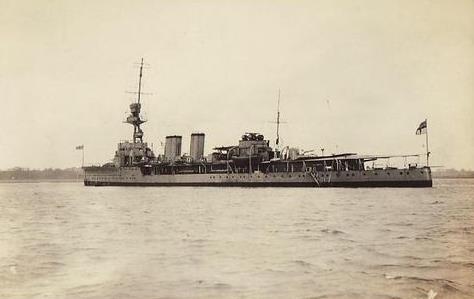
HMS Caledon
HMS Caledon was a C-class cruiser built by Cammell Laird and laid down on 17 March 1916, launched on 25 November 1916 and commissioned into the Navy on 6 March 1917. She was commissioned in time to see action in the Second Battle of Heligoland Bight. During the battle Ordinary Seaman John Henry Carless, although mortally wounded in the abdomen, still went on serving his gun and helping to clear away the casualties. He collapsed once, but got up again and cheered on the new gun’s crew. He then fell and died. He not only set a very inspiring example, but while mortally wounded continued to do effective work against the enemy. He was posthumously awarded a Victoria Cross. HMS Caledon survived the First World War and went on to see action in the Second World War.
Caledon spent the early part of the war with the Home Fleet, where she escorted convoys and was involved in the pursuit of the German battleships Scharnhorst and Gneisenau after the sinking of HMS Rawalpindi. She was reassigned to the Eastern Fleet between August 1940 and September 1942. She then rejoined the Home Fleet. Upon her arrival in the UK, she underwent conversion into an Anti-Aircraft cruiser at Chatham Dockyard between 14 September 1942 and 7 December 1943.Obsolete by the end of the war, she was disarmed in April 1945, and subsequently sold to be broken up for scrap on 22 January 1948. Caledon arrived at the yards of Dover Industries, Dover on 14 February 1948 to be scrapped.
HMS Carlisle
- Type. Light Cruiser
- Class. C
- Pennant. D67
- Builder. Fairfield
- Ordered. 1917
- Laid Down. 1917
- Launched. 09/07/1918
- Commissioned. 11/11/1918
- Speed. 29 knots
- Fate. Scrapped 1949
-
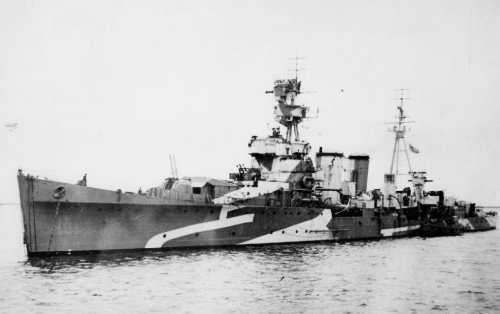
HMS Carlisle
HMS Carlisle was a C-class light cruiser she was laid down by Fairfield Shipbuilding and Engineering Company in 1917, and launched on 9 July 1918. She was completed with a hangar positioned under the bridge, and she was to carry aircraft. Carlisle was commissioned too late to see action in the First World War, and in 1919 Carlisle joined the 5th Light Cruiser Squadron at Harwich. During March she left Harwich in company with the squadron, and took up station in China.
In July 1943, she provided escort for the support force for the Allied landings in Sicily. During September-October, during the German counterattack in the Aegean Sea, Carlisle made a sortie into the area south of Piraeus with the destroyers HMS Panther and HMS Rockwood in order to intercept German convoys in the Scarpanto Strait. On 9 October 1943 they were spotted by German Ju 87 dive bombers from I. StG 3 of Megara Air Base which succeeded in sinking HMS Panther at 12.05 hrs and later on seriously damaged Carlisle. She was taken in tow to Alexandria by Rockwood. She was considered to be beyond economical repair as a warship, and instead was converted to serve as a base ship in the harbour of Alexandria in March 1944. She was last listed as a hulk in 1948 after the war had ended, and was broken up in 1949.
HMS Coventry
- Type. Cruiser
- Class. C
- Pennant. D43
- Builder. Swan Hunter
- Ordered. 1916
- Laid Down. 1916
- Launched. 07/07/1917
- Commissioned. 21/02/1918
- Speed. 29 knots
- Fate. Scuttled 14/09/1942

HMS Coventry
HMS Coventry was a Ceres-Class cruiser built by Swan Hunter at Newcastle up-on Tyne under the 1916 Emergency War Programme and to be named Corsair. The ship was laid down in August 1916 but at launch her name was changed to Coventry before launch on 7th July 1917.She joined the Harwich Force after Acceptance and preparation for operational service including the fit of a flying-off platform for aircraft. After service with Atlantic and Mediterranean Fleets she was selected in 1935 as the prototype for a new type of anti-aircraft cruiser and converted to the new role in HM Dockyard Portsmouth.
HMS Curlew
- Type. Light Cruiser
- Class. C
- Pennant. D42
- Builder. Vickers
- Laid Down. 21/08/1916
- Launched. 05/07/1917
- Commissioned. 14/12/1917
- Speed. 29 knots
- Fate. Sank 26/05/1940
-
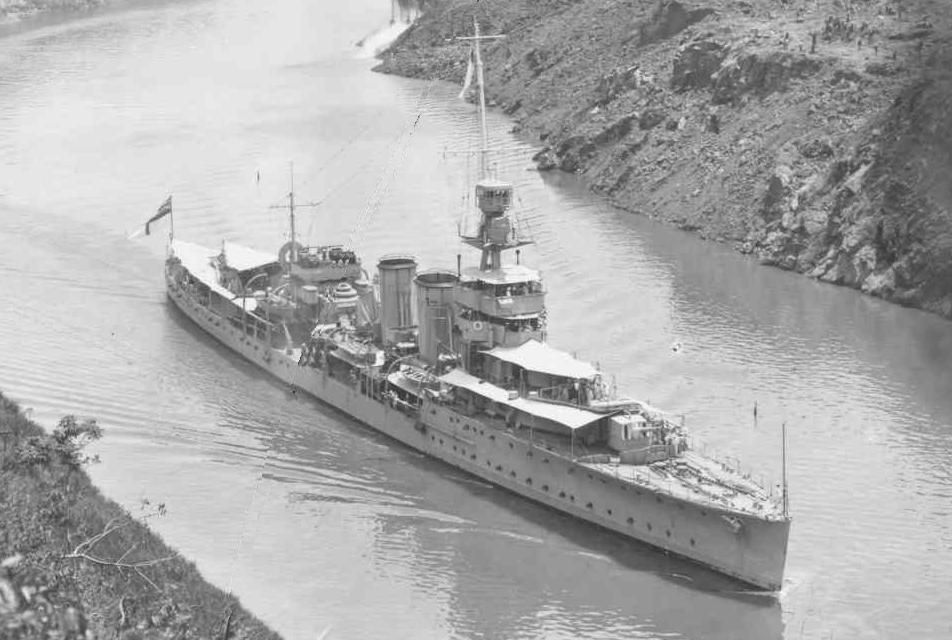
HMS Curlew
HMS Curlew was a C-class light cruiser and was laid down by Vickers Limited on 21 August 1916, and launched on 5 July 1917, being commissioned into the navy on 14 December 1917. By 1936 she had been placed in reserve at the Nore. On the outbreak of war she was commanded by Captain Basil Charles Barrington Brooke, and served with the Home Fleet. She participated in the Norwegian Campaign, and whilst operating off the Norwegian coast, she came under attack from German Ju-88 bombers and was sunk in Lavangsfjord, Ofotfjord near Narvik.
HMS Dauntless
- Type. Cruiser
- Class. D
- Pennant. D45
- Builder. Palmer
- Ordered. 1916
- Laid Down. 03/01/1917
- Launched. 10/04/1918
- Commissioned. 22/11/1918
- Speed. 29 knots
- Fate. Scrapped 13/02/1946
-
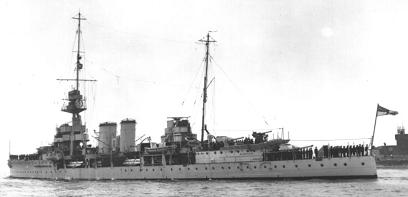
HMS Dauntless
HMS Dauntless was launched from Palmers Shipbuilding and Iron Company in 1918. At the outbreak of WW2, Dauntless was recommissioned and joined the 9th Cruiser Squadron with the South Atlantic Command.
In 1919 she was assigned to operate in the Baltic Sea against the Bolshevik revolutionaries in Russia. She was then on detached service in the West Indies. Following this assignment she was attached to the 1st Light Cruiser Squadron of the Atlantic Fleet for the following five years.
In 1935 she returned to Britain to be paid off into the reserve. She was sold to be broken up for scrap on 13 February 1946, and in April that year was broken up at the yards of T.W. Ward, of Inverkeithing.
HMS Devonshire
- Type. Heavy Cruiser
- Class. County
- Pennant. 39
- Builder. Devonport
- Ordered. 1925
- Laid Down. 16/03/1926
- Launched. 22/10/1927
- Commissioned. 18/03/1929
- Speed. 32 knots
- Fate. Scrapped 1954
-
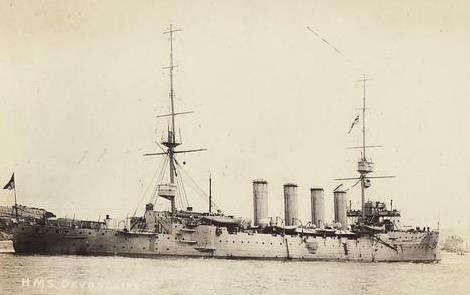
HMS Devonshire
HMS Devonshire was a County-class heavy cruiser of the Royal Navy. Constructed at Devonport Dockyard, she was launched on the 22nd October 1927, and commissioned two years later. On 21 November 1941, under the command of Captain Oliver, and with the help of her Supermarine Walrus, Devonshire located and then sank a German merchant raider, the auxiliary cruiser Atlantis, at a range of 14–15 km. Seven German sailors were killed. After the war, she was converted to the Royal Navy’s cadet training ship in 1947, in which role she served until 1953. In 1953 she took part in the Fleet Review to celebrate the Coronation of Queen Elizabeth II. Devonshire was sold for scrap on 16 June 1954 and arrived at Newport, Wales on 12 December 1954 where she was broken up.
HMS Neptune
- Type. Light Cruiser
- Class. Leander
- Pennant. 20
- Builder. Portsmouth Dockyard
- Ordered. 1931
- Laid Down. 24/09/1931
- Launched. 31/01/1933
- Commissioned. 12/02/1934
- Speed. 32.5 knots
- Fate. Sank 19/09/1941
-

HMS Neptune
HMS Neptune was a Leander-class light cruiser, Built by Portsmouth Dockyard, the vessel was laid down on 24 September 1931, launched on 31 January 1933, and commissioned into the Royal Navy on 12 February 1934. In December 1939, several months after war was declared, Neptune was patrolling in the South Atlantic in pursuit of German surface raider pocket battleship Admiral Graf Spee. Neptune, with other patrolling Royal Navy heavy units, was sent to Uruguay in the aftermath of the Battle of the River Plate.
Neptune was the first British ship to spot the Italian Fleet in the battle of Calabria, on 9 July 1940, marking also the first time since the Napoleonic wars that the Mediterranean Fleet received the signal ‘Enemy Battle Fleet in Sight’. During the subsequent engagement, she was hit by the Italian light cruiser Giuseppe Garibaldi. The 6-inch shell splinters damaged her floatplane beyond repair, its wreckage being thrown into the sea. Minutes later her main guns struck the heavy cruiser Bolzano three times, inflicting some damage on her torpedo room, below the water line and the “B” turret. During 1941, she led Force K, a raiding squadron of cruisers. Their task was to intercept and destroy German and Italian convoys en route to Libya. The convoys were supplying Rommel’s Afrika Korps in North Africa with troops and equipment, Neptune ran into an uncharted minefield in the Mediterranean off Tripoli, and sank with the loss of 764 officers and men. Just one man was rescued by an Italian torpedo boat, after 5 days in the water.
HMS Phoebe
- Type. Light Cruiser
- Class. Dido
- Pennant. 43
- Builder. Fairfield Shipbuilding
- Laid Down. 02/09/1937
- Launched. 25/03/1939
- Commissioned. 30/09/1940
- Speed. 32.25 knots
- Fate. Scrapped 01/08/1956
-
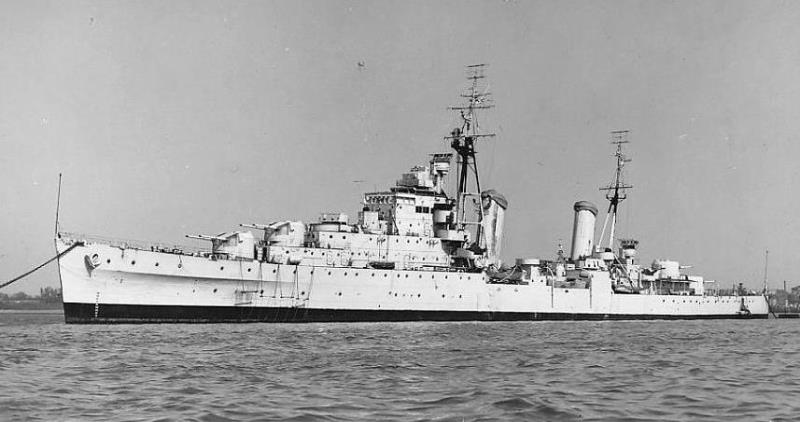
HMS Phoebe
HMS Phoebe was a Dido class light cruiser of the Royal Navy. She was built by Fairfield Shipbuilding and Engineering Company (Govan, Scotland), her keel was laid down on 2 September 1937. She was launched on 25 March 1939, and commissioned on 30 September 1940 after completion Phoebe was assigned the 15th Cruiser squadron as part of the Home Fleet and used in the North Atlantic on trade protection duties.
On 29 Oct, 1945, the cruiser arrived at Sheerness to refit and in 1946 joined the Mediterranean Fleet as flagship for the Destroyer Flotillas until November 1947, when she was assigned to the 1st Cruiser Squadron. On 14 Mar, 1951, the ship arrived at Chatham to be paid off, and then acted as senior officer´s ship in the Harwich reserve until 1955, followed by a year with the Portsmouth reserve. On 1 Aug, 1956, the ship arrived at Hughes Bolkow, Blyth to be broken up.
HMS Sirius
- Type. Light Cruiser
- Class. Dido
- Pennant. 82
- Builder. Portsmouth Dockyard
- Ordered. 1937
- Laid Down. 06/04/1938
- Launched. 18/09/1940
- Commissioned. 06/05/1942
- Speed. 32.25 knots
- Fate. Scrapped 15/10/1956
-
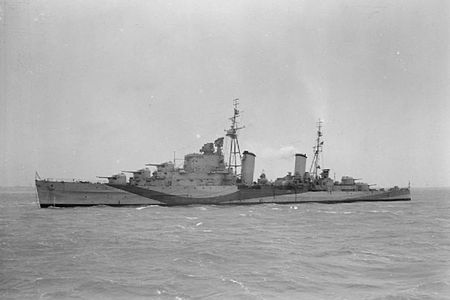
HMS Sirius
HMS Sirius was a Dido-class light cruiser. She was built by Portsmouth Dockyard She was launched on 18 September 1940, and commissioned 6 May 1942. The last naval battle held in Mediterranean Sea during 1942, saw HMS Sirius as protagonist. The Q Force (HMS Sirius, Aurora, Argonaut, destroyers Quentin and Quiberon) intercepted a small convoy in the Sicily Channel, starting the Battle of Skerki Bank. In the night of 2 December, a troop convoy was heading for Tunisia: German KT-1 , Aventino, Puccini (2,422 t), Aspromonte (a militarized ferry-boat, 976 tons). The Q Force intercepted the convoy in the night between 1 and 2 December. The British ships hit very hard and destroyed, one after the other, all the cargoes and troop ships. The escort ships were hit as well, with Folgore fatally damaged (9 133 mm direct hits) by cruisers, and later sunk with 120 dead (among them, Commander Ener Bettica), Da Recco badly damaged (explosion of the forward 120 mm ready ammunition depots) with 113 dead. Camicia Nera launched all of her six torpedoes, but missing the targets (mainly HMS Sirius). At dawn, the savage short-range engagement saw a clear British victory, while the Axis lost no less than 2,033 lives and five ships. This battle was almost forgotten but it was a big battle nevertheless, in which HMS Sirius was an absolute protagonist, escaping with no hit aboard despite the Camicia Nera, which fired on her from only 2 km, dodging several torpedoes and cooperating in the sinking of many Axis ships. In the return path HMS Quentin was sunk by 500 kg bombs released from Junkers 88s.
Sirius then formed part of the 12th Cruiser Squadron, was at the Allied invasion of Sicily, (Operation Husky), in July. Squadron, postwar until 1946. After a refit at Portsmouth in 1946, Sirius joined the 2nd Cruiser Squadron with the Home Fleet in March 1947. She was paid off in 1949 and was put up for disposal in 1956. On 15 October 1956 Sirius arrived at the Blyth yard of Hughes Bolkow for breaking up.
We are adding more information to this site on a regular basis, if you wish to submit any photos or provide any information on naval cruisers that were based or visited Harwich, then please use the contact page at the bottom of the screen.
Copyright Ownership.
We attempted to get the consent of copyright holders to use this material for nearly all of the photographs on the website.
In the few cases where names are available, a thorough search was made using telephone directories, photographic copyright directories, People Search and Google Area Search. None of the copyright owners could be traced in this way and we believe we have exhausted all reasonable avenues.
The consensus opinion of these authorities was that if any two of the following situations applied we would be deemed to have taken sufficient action to avoid infringing copyright laws:
- Reasonable efforts made to contact the copyright holder
- No financial gain will be made in relation to the photos
- A letter is obtained from present owner of photos
- There is a proviso included stating that if offence is caused document will be removed
The website owner undertakes to remove any photograph from the website where offence is caused. All the above conditions have therefore been met.
← Corvettes – World War 2 Cruisers – World War 1 →
